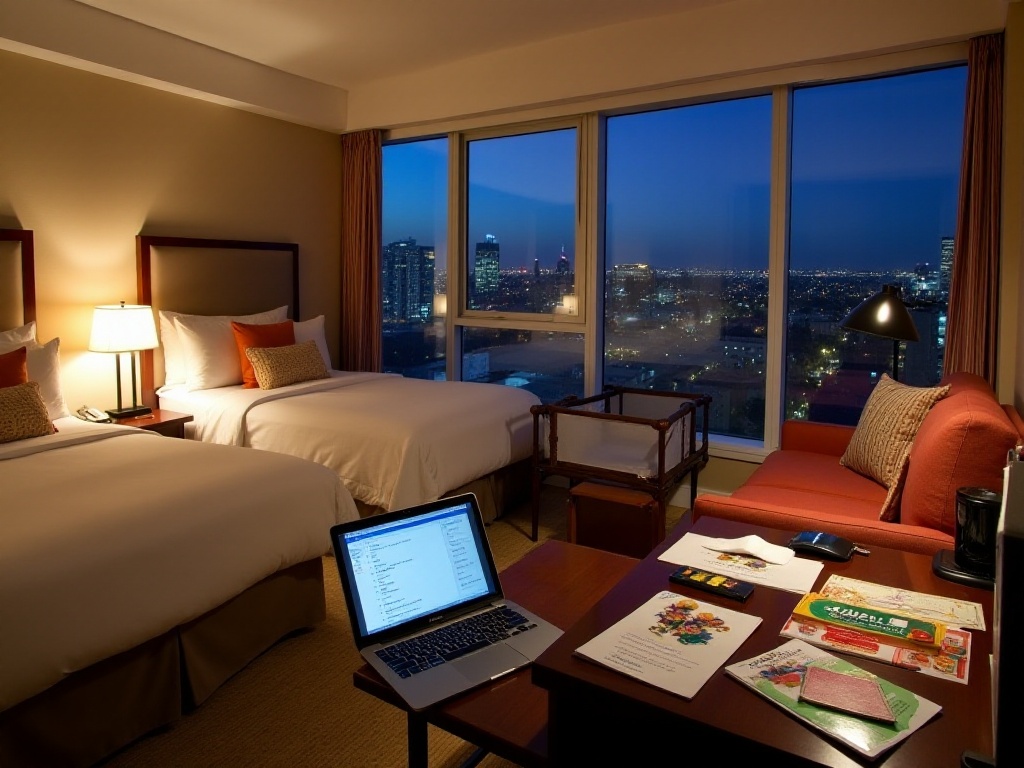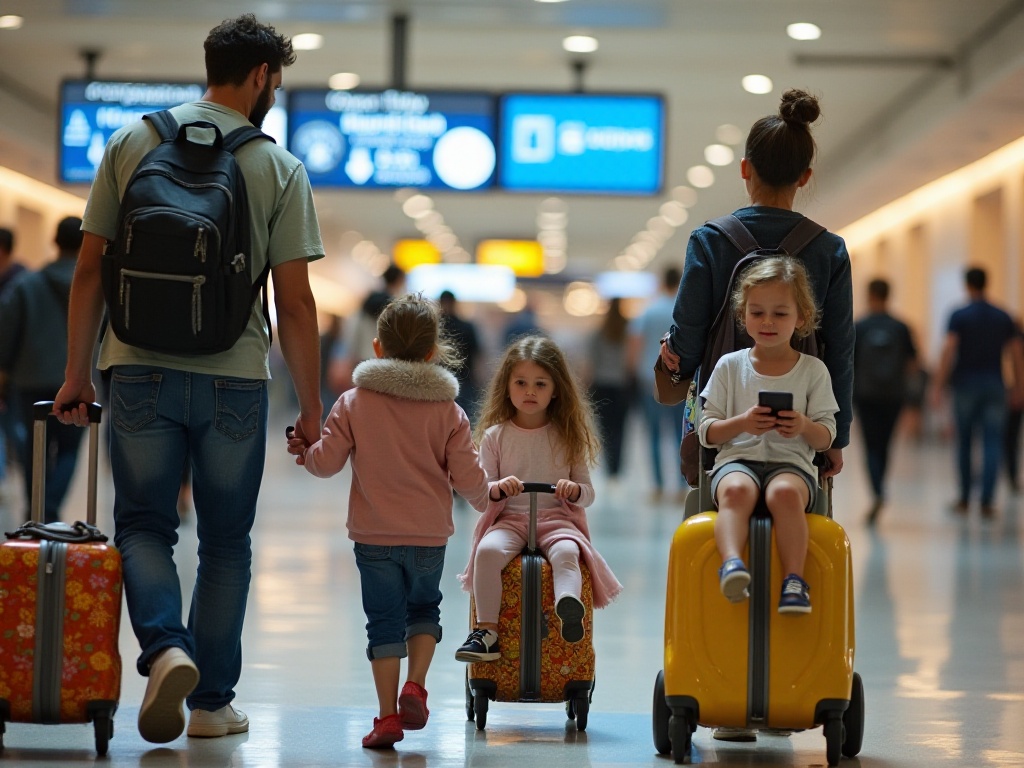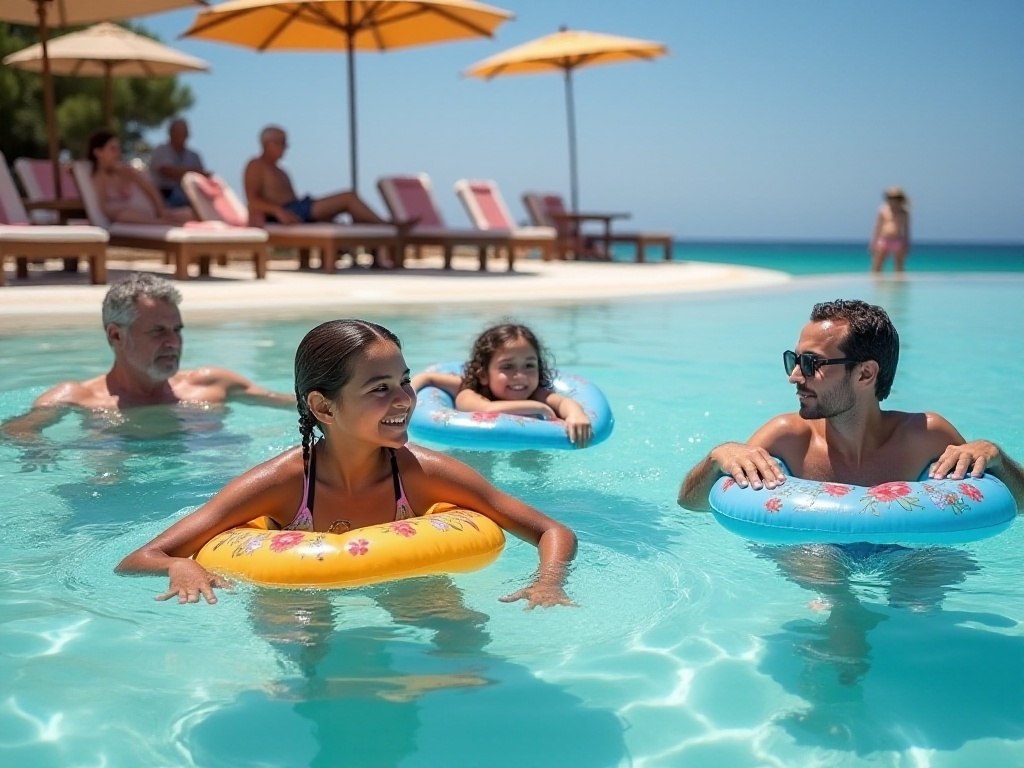Choosing the Right Destination
As a mom who has traveled the world with two children, I've encountered numerous challenges and learned many lessons before compiling these experiences. I still remember the first time I took my eldest out - I knew nothing and just wanted to visit a popular tourist spot. The result was disastrous: the scenic area was overcrowded with no rest areas, and my child ended up crying on the ground from exhaustion. I thought to myself: this trip was a complete failure.
After years of exploration, I'm now very careful when selecting destinations. Climate is always the first consideration - like last summer when we originally planned to visit Xinjiang, but after seeing temperatures regularly hitting 40°C (104°F), we changed our plans and went to Dali, a summer resort instead. This decision proved to be incredibly wise, as the cool weather made the children especially happy.
Medical facilities are also crucial. Once at a less-visited scenic spot, my younger child suddenly developed a fever, and we could only find one clinic in the entire town - they didn't even have fever medication. I was terrified. Since then, I always research local hospital locations in advance, especially pediatric hospitals.
The selection of attractions and activities is paramount. According to Ctrip's 2023 data, the family travel market is no longer satisfied with merely visiting attractions; many families are seeking interactive activities for children. For example, last year at Chimelong Ocean Kingdom, we not only watched spectacular shows, but the children also participated in a zookeeper experience program where they got to feed dolphins - their excitement was indescribable.
Many tourist areas are now developing family-friendly facilities, including nursing rooms, children's play areas, and family restrooms. I remember being moved to tears by the nursing rooms at Disney - they were spacious and bright, equipped with bottle warmers, changing tables, and even stroller rentals.
When choosing destinations, I suggest reading travel blogs, especially those from parent travelers, as their experiences are often very practical. You can also join family travel groups where moms are always willing to share their experiences.
I personally make very detailed plans before each trip. I not only research attraction information but also start monitoring local weather forecasts a week in advance. Because traveling with children is like pulling a thread that affects the whole fabric - the slightest oversight can impact the entire journey.
Another important factor is transportation convenience. High-speed rail has made travel much more convenient, but when choosing destinations, it's still important to check if there are direct transportation options. After all, transferring with children is particularly exhausting, so I always prefer places with direct transportation options when possible.
Trip Planning
Trip planning is truly an art. When I first started traveling with children, I always tried to pack the schedule full, afraid of wasting time. Looking back now, I was so naive - the most important thing when traveling with children is ensuring they have adequate rest time.
Last summer's Yunnan trip taught me a big lesson. I thought since we were already there, we should visit more places. So we spent the morning exploring Dali Ancient City for several hours, then rushed to Lijiang in the afternoon, staying in Lijiang Ancient City that night. While the itinerary looked perfect on paper, it exhausted the children. My eldest started complaining about being tired halfway through, and my younger one fell asleep right in the ancient city. My husband and I each had to carry one child - it was quite a sight.
Since then, I've set a rule for myself: plan only one main attraction per day, and leave plenty of time for rest. For example, we might visit an attraction in the morning and then rest at the hotel in the afternoon, letting the children engage in free activities. This not only prevents exhaustion but also allows children to better enjoy the travel experience.
When planning the schedule, I pay special attention to morning and evening times. Children's biological clocks are important, and they can easily become emotional if their routines are disrupted. So I try to plan according to their usual schedule - not leaving too early in the morning and ensuring they get enough sleep at night.
Weather factors must also be considered. Weather forecast apps are quite accurate now, so I check the weather in advance and adjust plans accordingly. We visit indoor attractions on rainy days and outdoor ones when the weather is nice. This not only prevents catching colds from rain but also makes the trip more comfortable.
Meal planning is also crucial. Children have smaller appetites but get hungry easily, so I always carry snacks. However, snacks need to be chosen carefully - not too many sweets to avoid affecting their appetite. I usually bring crackers and dried fruits that are easy to store and not too sweet.
In choosing attractions, I've also become more rational. Instead of going out of our way to visit trending spots, I choose places that are truly suitable for children. For example, when we went to Hangzhou last year, rather than squeezing onto the crowded Broken Bridge at West Lake, we spent more time at Hangzhou Amusement Park and Wildlife World. The children had a great time at these places and learned a lot too.
Speaking of learning, I believe travel is indeed an excellent opportunity for extracurricular education. We can tell historical stories at historical sites, teach geography at natural scenic spots, and learn about culture and art at museums. However, it's important to note that this education should be subtle and natural - if it feels too forced, children will find it boring.
My current trip planning follows one principle: better to visit fewer places and enjoy each one fully. Because the meaning of traveling with children isn't about how many places you visit, but about the parent-child interaction and happy experiences during the process.

Document Preparation
Document preparation is absolutely crucial. I've stumbled before due to document issues, so I take this very seriously now. The 2024 Japan visa policy change is a good example - many parents didn't know that school-age children now need to provide a "certificate of enrollment," only to discover at the visa application that their materials were insufficient, wasting valuable time.
Now I start preparing documents at least two months in advance. First are the basic identification documents, including ID cards, household registration books, and birth certificates. It's best to prepare several copies of these documents for backup. Birth certificates, in particular, are often needed for determining children's ticket eligibility at attractions.
Passports are quite convenient to obtain now, but validity periods need attention. Many countries require passports to be valid for at least six months upon entry, so check this in advance. If it's close to expiration, get it renewed immediately - don't wait until you need it to discover it's too late.
Visas require special attention too. Different countries have different visa requirements, and some have special requirements for minors. For example, visiting the United States requires not only basic visa materials but also parents' proof of assets and employment. So make sure to check the visa requirements for your destination country in advance and prepare all materials completely.
While domestic travel doesn't require as many documents, some basic ones are still necessary. ID cards are essential, as many hotels require real-name registration. Medical insurance cards should also be carried - while you might not need them, it's better to be prepared.
For group tours, pay attention to travel agency documents. Things like travel contracts and insurance documents should be carefully checked and photographed on your phone. Sometimes you might need them, and if you can't find the originals, photos can work in emergencies.
Speaking of insurance, it's truly crucial. I now buy insurance for the whole family when traveling, including accident and medical insurance. While we might not use it, having this protection provides peace of mind.
Another important tip is to photograph all important documents and store them in cloud storage. Because traveling with children can be hectic, and if original documents are lost, having digital copies can help in emergencies.
Safety Measures
When it comes to safety measures, there are countless lessons learned from experience. I still remember last year's experience in Thailand when my younger child suddenly developed a fever of 39°C (102.2°F). If we hadn't bought insurance in advance and found the best local hospital, I don't know what we would have done. So now I put extra emphasis on these preparations.
First is insurance, which is absolutely essential. I usually choose a combination of basic medical insurance and accident insurance, costing only 30-50 yuan per day, but it can really help in critical moments. When choosing insurance, pay special attention to coverage scope - some insurance only covers accidents, not illnesses, so read carefully.
Medical preparation is also crucial. I now carry a small medical kit with various common medications. This includes fever reducers, cold medicine, digestive medicine, motion sickness pills, etc. While we might not use them, it's better to be prepared. These medicines are especially essential when traveling with children.
Besides medications, some basic medical supplies should be prepared. Things like band-aids, gauze, and antiseptic solution should be kept on hand. Children are active and prone to minor bumps and scrapes. Having these supplies makes treatment much more convenient.
Protective items should also be well-stocked. Things like sunscreen and insect repellent are essential for protecting children. When choosing these products, check the ingredients and try to choose gentle ones to avoid irritating children's skin.
It's also important to research medical facilities at your destination in advance. I now look up local hospital distributions before trips, especially the locations of major hospitals and children's hospitals. I also save hospital phone numbers in my phone for emergencies.
Communication safeguards are also important. While network coverage is widespread now, communication tools should still be prepared. I usually have my children wear location watches so I don't worry about them getting lost. I also prepare a power bank to ensure phones always have power.
Safety education is essential. Before departure, clearly explain safety precautions to children, such as not talking to strangers, what to do if separated, how to seek help in emergencies, etc. All these should be communicated in advance.

Special Care for Infants and Toddlers
Traveling with babies from 6 weeks to 5 years old is truly a skilled task. I remember the first time I took my three-month-old baby on a plane - I packed an entire suitcase just with formula and diapers. Looking back now, many things could have been bought at the destination - there was no need to bring so much.
However, there are some essentials that must be prepared. First are common infant medications, like fever reducers and digestive medicines - these must be carried. Because infants are particularly vulnerable, any discomfort must be treated promptly.
Sun protection and insect protection are also very important. Infant skin is especially delicate, so you must choose specially formulated baby sunscreen and reapply frequently. Insect repellent should also be gentle, preferably specifically designed for babies.
Formula and supplementary food preparation also requires attention. For short trips, you can portion out regular formula into small packages. For longer trips, check if the same brand is available at your destination - if not, bring some emergency supply.
Diapers also need special attention. My current experience is to bring more for short trips, but for longer trips, just bring enough for the journey and buy the rest at the destination. Because diapers really take up space, and they're available everywhere now.
Stroller selection is also important. For air travel, I recommend choosing a lightweight umbrella stroller for easier check-in. For self-driving or high-speed rail travel, you can bring a larger stroller for the child's comfort.
For accommodation, always choose rooms with private bathrooms. When traveling with infants, you might need to get up several times during the night, and shared bathrooms would be very inconvenient. It's best to have a small kitchen for warming milk and preparing supplementary food.
Timing also requires special attention. Infants' biological clocks are very important, so try to maintain their regular routines as much as possible. Especially sleep time - ensure it's adequate, or they'll easily become fussy.
Managing Teenagers
Traveling with teenagers is actually more challenging than with young children. They're in their rebellious phase, have their own ideas, and are particularly concerned about social life. My eldest is 14 now, and we always discuss and plan trips with her in advance, letting her participate in the planning.
I've found that involving teenagers in travel planning is actually a great educational opportunity. They can learn how to search for information, make plans, control budgets, etc. The planning process also increases their sense of responsibility and ownership.
During travel, I give teenagers some freedom. For example, in safe scenic areas, they can explore on their own without adults following. This not only satisfies their need for independence but also cultivates their autonomy.
Social needs must also be considered. Today's teenagers can't be separated from their phones, so I relax phone usage restrictions somewhat. But we agree on specific usage times, like no phones during meals and not constantly taking videos while playing.
When choosing attractions, consider teenagers' interests. For example, my eldest particularly likes history, so we visit more historical sites. My younger one likes music, so we go to performances. This way they can truly engage in the travel experience.
Regarding shopping, I give them some budget autonomy. Let them plan how to spend this money and what to buy. This cultivates their financial awareness while helping them understand the value of money.

Transportation Choices
Regarding transportation choices, I've gained quite a bit of experience. For journeys under 4 hours, I prefer high-speed rail or self-driving. Both these methods give children more space to move around, unlike airplanes where they have to sit still the whole time.
High-speed rail conditions are really good now. Spacious seats, clean bathrooms, stable internet - all these make traveling with children much easier. Plus, high-speed rail stations are usually in city centers, making transportation very convenient, unlike airports where you need to leave very early.
Self-driving is my favorite way to travel. It offers the highest degree of freedom - stop when you want, go when you want. Plus you can bring lots of things without worrying about baggage weight limits. This is especially convenient when traveling with children, as you often need to bring many items.
However, self-driving requires attention to certain issues. First is checking the car's condition in advance, especially crucial parts like tires and oil. Then prepare some emergency items like jacks, spare tires, fire extinguishers, etc.
If flying is unavoidable, I've summarized some experiences. For example, choose suitable flight times, preferably avoiding very early morning or late night flights, as these disrupt children's routines.
When booking flights with infants, be sure to mention this in advance so the airline can arrange seats near bathrooms. For older children, window seats are better so they can look at the scenery outside.
Luggage preparation also requires attention. I now pack children's toys, snacks, and change of clothes in separate bags for easy access. Also prepare some emergency items like wet wipes and garbage bags, just in case.
Accommodation Considerations
Choosing accommodation is indeed a major consideration. I pay particular attention to several points: First, location should be good, preferably near hospitals or pharmacies, with convenience stores nearby. Because with children, you might need these facilities at any time.
Room selection is also important. Must have private bathroom and shower, making it more convenient to care for children at night. If budget allows, suites are best so adults and children can sleep separately without disturbing each other.
Many hotels now offer family-themed rooms, and while they're 20-30% more expensive than standard rooms, the facilities are really thoughtful. They're equipped with children's beds, baby bathtubs, sterilizers, and even provide some toys and picture books.
I now pay special attention to reviews when booking hotels. Not just overall ratings, but specifically what families with children say, as their experiences are more relevant. Particularly look at cleanliness and soundproofing details.
Location selection is also important. If visiting scenic areas, best to stay within or near the scenic area for convenient travel. In cities, consider transportation convenience and area safety.
Service is also a key consideration. Good service can make travel much easier. Some hotels provide pickup services, help order takeout, arrange vehicles, etc. - these all bring great convenience to traveling with children.

Budget Control
Regarding budget control, I have a very practical suggestion: divide the total budget into several parts - 30% for transportation, 35% for accommodation, 20% for food, and 15% for attractions and shopping. Of course, this is just a reference to be adjusted according to actual circumstances.
For transportation costs, booking tickets in advance can save quite a bit. Especially airline tickets - booking a month ahead is much cheaper than last-minute booking. Also pay attention to various promotional activities, which can sometimes save significant money.
Accommodation is the largest expense. My suggestion is, rather than staying in many cheap hotels, better to stay in fewer but better ones. Because good accommodation allows everyone to rest better and enjoy more.
Food costs can actually be reduced somewhat. No need to eat every meal at restaurants; you can buy some fruit and bread for breakfast. This is both economical and healthy. However, pay attention to hygiene, especially with children - always choose reliable places.
Attraction tickets can usually be booked online now, and often have discounts. I always compare prices across platforms and buy where it's cheapest. Also check children's ticket standards carefully - some attractions calculate by height, others by age.
Shopping should be moderate - don't buy everything you see. I now give children a shopping budget and let them plan how to spend it. This helps them learn financial management while avoiding oversp








